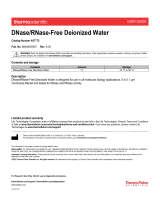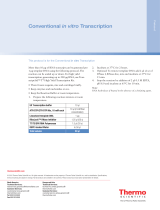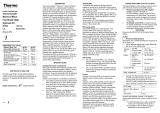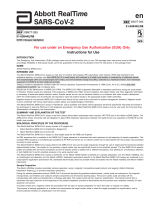Page is loading ...

RNA UltraSense™ One-Step Quantitative RT-PCR System
Catalog Numbers 11732927
Doc. Part No. 11732927.pps Pub. No. MAN0001007 Rev. 3.0
WARNING! Read the Safety Data Sheets (SDSs) and follow the handling instructions. Wear appropriate protective eyewear,
clothing, and gloves. Safety Data Sheets (SDSs) are available from thermofisher.com/support.
Product description
The RNA UltraSense™ One-Step Quantitative RT-PCR System is a one-step quantitative RT-PCR system for the sensitive, reproducible
detection of low-abundance RNA molecules using real-time detection instruments. This system combines the high-temperature reverse
transcription capability of SuperScript™ III Reverse Transcriptase with the automatic hot-start PCR provided by Platinum™ Taq DNA
Polymerase in a highly concentrated formulation that is optimized for the detection of viral RNA and rare transcripts. Both cDNA synthesis
and PCR are performed in a single tube using gene-specic primers and RNA. All components necessary for real-time RT-PCR are mixed
in the tube, and reverse transcription is directly followed by PCR cycling without additional handling, enabling sensitive detection from as
few as 10 copies of highly dilute RNA template.
Contents and storage
Contents Amount Storage
RNA UltraSense™ Enzyme Mix[1] 250 µL
15°C to 30°C[2]
RNA UltraSense™ 5X Reaction
Mix[3] 1 mL
20X Bovine Serum Albumin (BSA),
UltraPure, non-acetylated, 1
mg/mL
300 µL
Magnesium Sulfate (MgSO4), 50
nM 1 mL
ROX™ Reference Dye[4] 100 µL
[1] Includes RNaseOUT™ Recombinant Ribonuclease Inhibitor.
[2] Stabiity can be extended by storing at -80°C
[3] Contains 1 mM of each dNTP.
[4] Store in the dark.
Quality control
The RNA UltraSense™ One-Step Quantitative RT-PCR System is
tested functionally by quantitative real-time analysis using total
HeLa RNA as template. Kinetic analysis must demonstrate a linear
dose response with decreasing target concentration and
detection of β-actin mRNA in 1 pg of total HeLa RNA.
Required material not supplied
Unless otherwise indicated, all materials are available through
thermofisher.com. "MLS" indicates that the material is available
from fisherscientific.com or another major laboratory supplier.
Item Source
One of the following instruments, or equivalent[1]
Applied Biosystems™ 7500 Fast Food Safety
Real-Time PCR Instrument
A30304 (desktop)
A30299 (laptop)
Contact your local
microbiology sales
representative
QuantStudio™ 5 Food Safety Real-Time PCR
Instrument
A36320 (desktop)
A36328 (laptop)
Contact your local
microbiology sales
representative
Additional materials for PCR
Vortex mixer
Available through the
Thermo Fisher
Microbiology ordering
process. See
thermofisher.com/
plastics for more
information.
8-channel pipette, 10‑ to 100‑µL
Filtered pipette tips, 10‑ to 100‑µL
Benchtop microcentrifuge with adaptors for
PCR plates and/or tubes
1.5-mL nuclease-free microcentrifuge tubes
Powder-free disposable gloves
USER GUIDE
For Research Use Only. Not for use in diagnostic procedures.

Item Source
Optical reaction plates and covers, or optical PCR tubes and
caps
MicroAmp™ Fast Optical 96-Well Reaction
Plate, 0.1 mL 4346907
MicroAmp™ Optical Adhesive Film, 100 covers 4311971
MicroAmp™ Fast 8-Tube Strip, 0.1 mL
(See below for caps.) 4358293
MicroAmp™ Optical 8-Cap Strips 4323032
Reagents
Nuclease-free Water (not DEPC-Treated) AM9938
Ethanol MLS
[1] Other Applied Biosystems™ 7500 Fast Real‑Time PCR Instrument and
QuantStudio™ 5 Real‑Time PCR Instrument are also suitable.
Procedural guidelines
Guidelines for reaction setup and conditions
• RNA should be devoid of any RNase contamination and
aseptic conditions should be maintained. RNaseOUT™
Recombinant Ribonuclease Inhibitor is included in the
enzyme mix to safeguard against degradation of target RNA
due to ribonuclease contamination of the RNA preparation.
• The RNA UltraSense™ 5X Reaction Mix includes MgSO4 at a
concentration that facilitates primer binding with difcult
templates such as viral RNA. If necessary, use the 50-mM
MgSO4 solution included in the kit to increase the
magnesium concentration.
• Keep all components, reaction mixes and samples on ice.
After reaction assembly, transfer them to a thermal cycler
pre-heated to the desired cDNA synthesis temperature (45–
60°C) and immediately start the RT-PCR amplication
program.
•Efcient cDNA synthesis can be accomplished in a
incubation at 45–60°C for 15-30 minutes. Optimal
temperature varies for different primers and templates. A
good general starting point is 50°C for 15 minutes. For
problematic templates, or to increase the specicity of cDNA
priming, increase the cDNA synthesis temperature to 55°C.
• The SuperScript™ III Reverse Transcriptase is inactivated, the
RNA/cDNA hybrid is denatured, and the Platinum™ Taq DNA
Polymerase is activated during the incubation at 95°C for 2
minutes.
• The annealing temperature should be 0–10°C below the
melting temperature of the primers used.
• The extension time of 30 seconds for instruments that use
PCR tubes/plates is appropriate for the short amplicons that
are typically used in real-time PCR.
Guidelines for primer selection
•Gene-specic primers (GSP) are required. We do not
recommend using oligo(dT) or random primers, which may
generate nonspecic products in the one-step procedure
and reduce the amount of product.
• For mRNA, design primers that anneal to exons on both
sides of an intron or within the exon/exon boundary to allow
differentiation between amplication of cDNA and potential
contaminating genomic DNA.
• Primers should be designed according to standard PCR
guidelines. They should be specic for the target sequences,
be free of internal secondary structure, and should avoid
complementation at 3′ end within each primer, primer pair, or
hybridization probe sequence (except as required for hairpin
uorogenic primers such as LUX™ primers). For best results,
the amplicon size should be limited to 80–200 bp.
• Optimal results may require a primer titration between 100
and 500 nM. A nal concentration of 200 nM per primer is
effective for most reactions.
• For multiplex applications, limit the amount of primer for the
reference gene, such as β-actin or GAPDH, to avoid
competition between amplication of the reference gene and
sample gene. In general, the nal concentration of the
reference gene primer should be between 25 and 100 nM.
However, a primer titration is recommended for optimal
results.
Guidelines for dual-labeled probes
• The optimal concentration of probe may vary between 50
and 800 nM. A recommended starting concentration is 100
nM.
• The probe sequence should be free of secondary structure
and should not hybridize to itself or to primer 3′ ends.
• For multiplex applications, the concentration of each probe
may need to be adjusted independently to obtain optimal
uorescent signals. The amount of probe for the reference
gene, such as β- actin or GAPDH, should be limited as
described above for primers.
2RNA UltraSense™ One-Step Quantitative RT-PCR System User Guide

Set up the RT-PCR reactions
1. Set up the real-time PCR instrument as indicated in the following table
Table 1 Cycling conditions
Step No. of cycles Temp. Time
Reverse transcription 1 50°C[1] 15 min
Polymerase activation 1 95°C 2 min
Amplification
40-50
95°C 15 sec
60°C 30 sec
Melt curve (optional) 1 Refer to the real-time PCR instrument doumentation.
[1] 42-50°C is acceptable. Use 50°C as a starting point.
Optimal temperatures and incubation times may vary for different target sequences.
2. On ice, prepare an RT-PCR Master Mix for the number of reactions required plus 10% overage.
Component 10-µL RT-PCR reaction 20-µL RT-PCR reaction
RNA UltraSense™ Enzyme Mix 0.5 µL 1 µL
RNA UltraSense™ 5X Reaction Mix 2 µL 4 µL
LUX™ Primers[1]
or
TaqMan™ Probes [2]
0.2 µL each 0.4 µL each
(Optional) ROX™0.2 µL 0.4 µL
Total Master Mix Volume 3.1 µL 6.2 µL
[1] Labeled primer: 10 µM, Unlabeled primer: 10 µM
[2] Primer pair: 10 µM each, Fluorogenic probe: 10 µM
3. On ice, add template and Nuclease-free Water (not DEPC-Treated) to the RT-PCR Master Mix according to the following table.
Component 10-µL RT-PCR reaction 20-µL RT-PCR reaction
RT-PCR Master Mix 3.1 µL 6.2 µL
Template Up to 6.9 µL Up to 13.8 µL
Nuclease-free Water (not DEPC-Treated) To 10 µL To 20 µL
Total RT-PCR Volume 10 µL 20 µL
4. Cap or seal the reaction vessels, and gently mix to make sure that all components are at the bottom of the amplication tube.
Centrifuge briey if needed.
5. Place reactions in a preheated thermal cycler programmed as described above. Collect data and analyze results. After cycling, hold
the reaction at 4°C until further analysis.
Troubleshooting
Observation Possible cause Recommended action
No amplification product
Relative fluorescent signal ≤
background or no template control
cDNA synthesis temperature too
high, low priming efficiency.
Lower incubation temperature.
RT or cDNA primer blocked by
secondary structure.
Raise incubation temperature. Redesign primer(s).
RNA has been damaged or
degraded.
Replace RNA if necessary.
RNA UltraSense™ One-Step Quantitative RT-PCR System User Guide 3

Observation Possible cause Recommended action
No amplification product
Relative fluorescent signal ≤
background or no template control
(continued)
RNase contamination. Maintain aseptic conditions; add RNase inhibitor.
Fluorescent probe not functional. Validate probe design and presence of fluorophore and quencher:
Treat TaqMan™ probe with DNase, and check for increase in
fluorescence. Redesign and/or resynthesize probe if necessary.
Poor sensitivity Not enough starting template RNA. Increase the concentration of template RNA; use 10 ng to 1 μg of
total RNA.
Product detected at higher than
expected cycle number
RNA has been damaged or
degraded.
Replace RNA if necessary.
RNase contamination. Maintain aseptic conditions; add RNase inhibitor.
RT inhibitors are present in RNA. Remove inhibitors in the RNA preparation by an additional 70%
ethanol wash. Inhibitors of RT include SDS, EDTA, guanidium salts,
formamide, sodium phosphate and spermidine.
Inefficient cDNA synthesis. Adjust cDNA synthesis temperature and/or primer design.
Inefficient PCR amplification. Optimize PCR conditions:
• Adjust annealing temperature as necessary.
• Increase magnesium concentration.
• Redesign primers.
Higher than expected signal Too much sample added to
reactions.
Decrease the concentration of template RNA.
Product detected at lowerthan-
expected cycle number, and/or
positive signal from no-template
controls
Template or PCR carry-over
contamination.
Isolate source of contamination and replace reagent(s). Use separate
dedicated pipettors for reaction assembly and post-PCR analysis.
Assemble reactions (except for target addition) in a DNA-free area.
Use aerosol-resistant pipet tips or positive displacement pipettors.
Unexpected bands after
electrophoresis
RNA contamination with genomic
DNA.
Pre-treat RNA with DNase I.
Oligo(dT) or random primers used
for first-strand synthesis.
Use gene-specific primers.
Low specificity in PCR. Optimize PCR conditions as described above.
Limited product warranty
Life Technologies Corporation and/or its afliate(s) warrant their products as set forth in the Life Technologies' General Terms and
Conditions of Sale at www.thermofisher.com/us/en/home/global/terms-and-conditions.html. If you have any questions, please
contact Life Technologies at www.thermofisher.com/support.
Life Technologies Corporation | 7335 Executive Way | Frederick, MD 21704 | USA
For descriptions of symbols on product labels or product documents, go to thermofisher.com/symbols-definition.
The information in this guide is subject to change without notice.
DISCLAIMER: TO THE EXTENT ALLOWED BY LAW, THERMO FISHER SCIENTIFIC INC. AND/OR ITS AFFILIATE(S) WILL NOT BE LIABLE FOR SPECIAL, INCIDENTAL, INDIRECT,
PUNITIVE, MULTIPLE, OR CONSEQUENTIAL DAMAGES IN CONNECTION WITH OR ARISING FROM THIS DOCUMENT, INCLUDING YOUR USE OF IT.
Important Licensing Information: These products may be covered by one or more Limited Use Label Licenses. By use of these products, you accept the terms and conditions of all
applicable Limited Use Label Licenses.
©2020 Thermo Fisher Scientic Inc. All rights reserved. All trademarks are the property of Thermo Fisher Scientific and its subsidiaries unless otherwise specified. TaqMan is a
registered trademark of Roche Molecular Systems, Inc., used under permission and license.
thermofisher.com/support | thermofisher.com/askaquestion
thermofisher.com
1 June 2020
/












